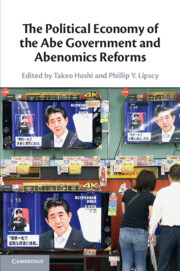25 results
Part II - Political Context
-
- Book:
- The Political Economy of the Abe Government and Abenomics Reforms
- Published online:
- 05 February 2021
- Print publication:
- 25 February 2021, pp 41-136
-
- Chapter
- Export citation
1 - The Political Economy of the Abe Government
- from Part I - Introduction
-
-
- Book:
- The Political Economy of the Abe Government and Abenomics Reforms
- Published online:
- 05 February 2021
- Print publication:
- 25 February 2021, pp 3-40
-
- Chapter
- Export citation
Part III - Macroeconomic Policy
-
- Book:
- The Political Economy of the Abe Government and Abenomics Reforms
- Published online:
- 05 February 2021
- Print publication:
- 25 February 2021, pp 137-268
-
- Chapter
- Export citation
6.A - Data appendix
- from 6 - Abenomics, Monetary Policy, and Consumption
-
- Book:
- The Political Economy of the Abe Government and Abenomics Reforms
- Published online:
- 05 February 2021
- Print publication:
- 25 February 2021, pp 168-169
-
- Chapter
- Export citation
Contributors
-
- Book:
- The Political Economy of the Abe Government and Abenomics Reforms
- Published online:
- 05 February 2021
- Print publication:
- 25 February 2021, pp xvi-xxiv
-
- Chapter
- Export citation
Contents
-
- Book:
- The Political Economy of the Abe Government and Abenomics Reforms
- Published online:
- 05 February 2021
- Print publication:
- 25 February 2021, pp vii-ix
-
- Chapter
- Export citation
Appendix - Descriptive Statistics forand
- from 11 - Abe’s Womenomics Policy
-
- Book:
- The Political Economy of the Abe Government and Abenomics Reforms
- Published online:
- 05 February 2021
- Print publication:
- 25 February 2021, pp 354-356
-
- Chapter
- Export citation
Part I - Introduction
-
- Book:
- The Political Economy of the Abe Government and Abenomics Reforms
- Published online:
- 05 February 2021
- Print publication:
- 25 February 2021, pp 1-40
-
- Chapter
- Export citation
Part V - Foreign Policy
-
- Book:
- The Political Economy of the Abe Government and Abenomics Reforms
- Published online:
- 05 February 2021
- Print publication:
- 25 February 2021, pp 477-533
-
- Chapter
- Export citation
Copyright page
-
- Book:
- The Political Economy of the Abe Government and Abenomics Reforms
- Published online:
- 05 February 2021
- Print publication:
- 25 February 2021, pp iv-iv
-
- Chapter
- Export citation
Abbreviations
-
- Book:
- The Political Economy of the Abe Government and Abenomics Reforms
- Published online:
- 05 February 2021
- Print publication:
- 25 February 2021, pp xxvii-xxx
-
- Chapter
- Export citation
Index
-
- Book:
- The Political Economy of the Abe Government and Abenomics Reforms
- Published online:
- 05 February 2021
- Print publication:
- 25 February 2021, pp 534-542
-
- Chapter
- Export citation
Acknowledgments
-
- Book:
- The Political Economy of the Abe Government and Abenomics Reforms
- Published online:
- 05 February 2021
- Print publication:
- 25 February 2021, pp xxv-xxvi
-
- Chapter
- Export citation
7 - The Great Disconnect
- from Part III - Macroeconomic Policy
-
-
- Book:
- The Political Economy of the Abe Government and Abenomics Reforms
- Published online:
- 05 February 2021
- Print publication:
- 25 February 2021, pp 170-199
-
- Chapter
- Export citation
Technical Appendix
- from 9 - The Crisis That Wasn’t
-
- Book:
- The Political Economy of the Abe Government and Abenomics Reforms
- Published online:
- 05 February 2021
- Print publication:
- 25 February 2021, pp 264-268
-
- Chapter
- Export citation
Part IV - Third Arrow of Abenomics
-
- Book:
- The Political Economy of the Abe Government and Abenomics Reforms
- Published online:
- 05 February 2021
- Print publication:
- 25 February 2021, pp 269-476
-
- Chapter
- Export citation
Tables
-
- Book:
- The Political Economy of the Abe Government and Abenomics Reforms
- Published online:
- 05 February 2021
- Print publication:
- 25 February 2021, pp xiv-xv
-
- Chapter
- Export citation
Dedication
-
- Book:
- The Political Economy of the Abe Government and Abenomics Reforms
- Published online:
- 05 February 2021
- Print publication:
- 25 February 2021, pp v-vi
-
- Chapter
- Export citation
Figures
-
- Book:
- The Political Economy of the Abe Government and Abenomics Reforms
- Published online:
- 05 February 2021
- Print publication:
- 25 February 2021, pp x-xiii
-
- Chapter
- Export citation

The Political Economy of the Abe Government and Abenomics Reforms
-
- Published online:
- 05 February 2021
- Print publication:
- 25 February 2021



